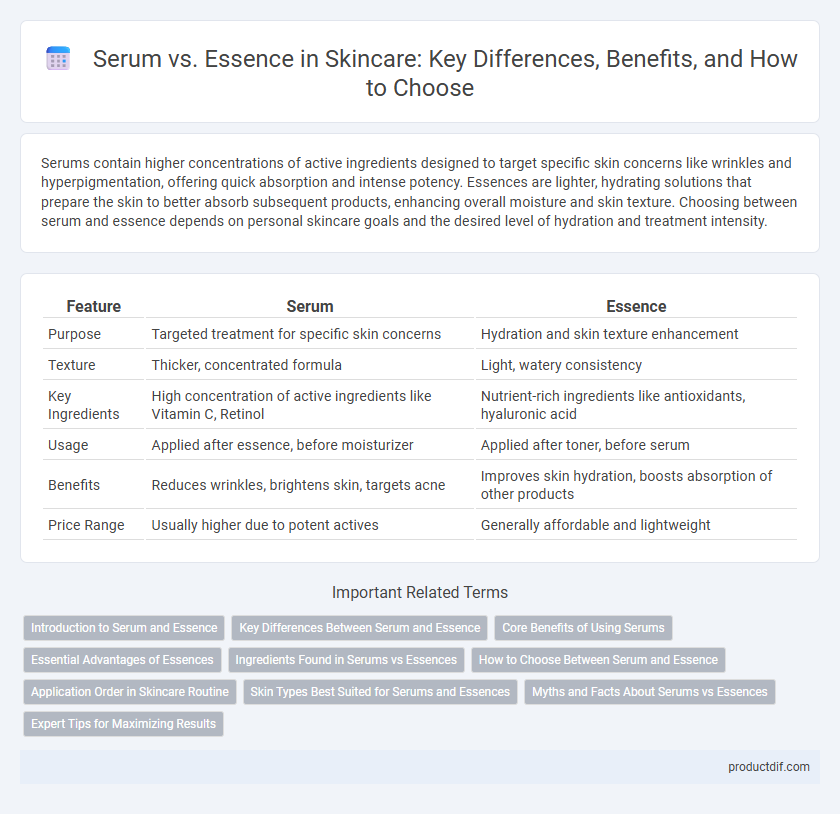Serums contain higher concentrations of active ingredients designed to target specific skin concerns like wrinkles and hyperpigmentation, offering quick absorption and intense potency. Essences are lighter, hydrating solutions that prepare the skin to better absorb subsequent products, enhancing overall moisture and skin texture. Choosing between serum and essence depends on personal skincare goals and the desired level of hydration and treatment intensity.
Table of Comparison
| Feature | Serum | Essence |
|---|---|---|
| Purpose | Targeted treatment for specific skin concerns | Hydration and skin texture enhancement |
| Texture | Thicker, concentrated formula | Light, watery consistency |
| Key Ingredients | High concentration of active ingredients like Vitamin C, Retinol | Nutrient-rich ingredients like antioxidants, hyaluronic acid |
| Usage | Applied after essence, before moisturizer | Applied after toner, before serum |
| Benefits | Reduces wrinkles, brightens skin, targets acne | Improves skin hydration, boosts absorption of other products |
| Price Range | Usually higher due to potent actives | Generally affordable and lightweight |
Introduction to Serum and Essence
Serum and essence are key skincare products designed to deliver concentrated active ingredients deep into the skin. Serums typically contain higher concentrations of potent ingredients like hyaluronic acid, vitamin C, and retinol, targeting specific concerns such as wrinkles, dark spots, and hydration. Essences feature a lightweight, hydrating formula that enhances skin absorption and preparation, boosting the effectiveness of subsequent treatments.
Key Differences Between Serum and Essence
Serums contain a higher concentration of active ingredients such as antioxidants and peptides, designed for targeted treatment of specific skin concerns like wrinkles and hyperpigmentation. Essences have a lighter, water-based formulation that primarily focuses on hydration and enhancing skin absorption of subsequent products. While serums deliver potent results with thicker consistency, essences prepare and soothe the skin, boosting overall skincare efficacy.
Core Benefits of Using Serums
Serums deliver highly concentrated active ingredients designed to penetrate deeply into the skin, targeting specific concerns such as fine lines, wrinkles, and hyperpigmentation. Their lightweight, fast-absorbing formulas enhance skin texture by boosting hydration and promoting collagen production. Regular use of serums results in visibly brighter, smoother, and firmer skin.
Essential Advantages of Essences
Essences deliver concentrated hydration with lightweight formulas that absorb quickly, making skin softer and more receptive to subsequent treatments. Their higher water content compared to serums enhances skin moisture balance without heaviness, ideal for layering in multi-step skincare routines. Essences also boost skin cell turnover and improve overall texture by infusing essential nutrients efficiently.
Ingredients Found in Serums vs Essences
Serums typically contain higher concentrations of active ingredients such as antioxidants, peptides, and vitamins like C and E, designed for targeted treatment of specific skin concerns. Essences often have lighter formulations with hydrating ingredients like hyaluronic acid and fermented extracts, aimed at boosting skin moisture and preparing the skin for subsequent products. The ingredient profile in serums emphasizes potency and rapid absorption, whereas essences prioritize gentle hydration and enhanced skin receptivity.
How to Choose Between Serum and Essence
Choosing between serum and essence depends on your skin concerns and goals; serums contain high concentrations of active ingredients targeting specific issues like wrinkles or pigmentation, while essences focus on hydrating and prepping skin for better absorption. Consider your skin type--serums are ideal for oily or acne-prone skin due to their lightweight texture, whereas essences suit dry or sensitive skin by providing gentle moisture. Prioritize ingredients such as hyaluronic acid in essences for hydration or vitamin C in serums for brightening effects to optimize your skincare routine.
Application Order in Skincare Routine
In a skincare routine, essence is typically applied immediately after cleansing and toning to hydrate and prep the skin, while serum follows to deliver concentrated active ingredients for targeted treatment. Essence has a lighter, watery texture designed for rapid absorption, setting the stage for the thicker, nutrient-dense serum. Proper application order enhances the efficacy of both products, maximizing skin hydration and targeted benefits.
Skin Types Best Suited for Serums and Essences
Serums are highly concentrated skincare products ideal for targeting specific concerns like acne, aging, and hyperpigmentation, making them best suited for oily, combination, or mature skin types needing potent active ingredients. Essences, with their lightweight, hydrating formulas, excel in boosting moisture and preparing the skin for subsequent treatments, thus benefiting dry, sensitive, or normal skin by enhancing overall hydration and skin barrier function. Choosing between serum and essence depends on individual skin needs, with serums addressing targeted concerns and essences focusing on hydration and skin health maintenance.
Myths and Facts About Serums vs Essences
Serums and essences, while both deliver active ingredients, differ in concentration and texture, with serums typically being thicker and richer in potent actives compared to the lighter, more hydrating essences. A common myth is that essences are just diluted serums; in reality, essences focus on prepping the skin for better absorption while serums target specific skin concerns like wrinkles or pigmentation. Understanding these distinctions helps optimize skincare routines by combining essences for hydration and serums for targeted treatment.
Expert Tips for Maximizing Results
Experts recommend layering serum before essence to enhance ingredient absorption and target specific skin concerns effectively. Choose serums with concentrated active ingredients like vitamin C or hyaluronic acid, and pair them with hydrating essences containing antioxidants to boost overall skin vitality. Applying serums on slightly damp skin improves penetration, while gentle patting motions ensure even distribution and maximize product benefits.
Serum vs Essence Infographic

 productdif.com
productdif.com